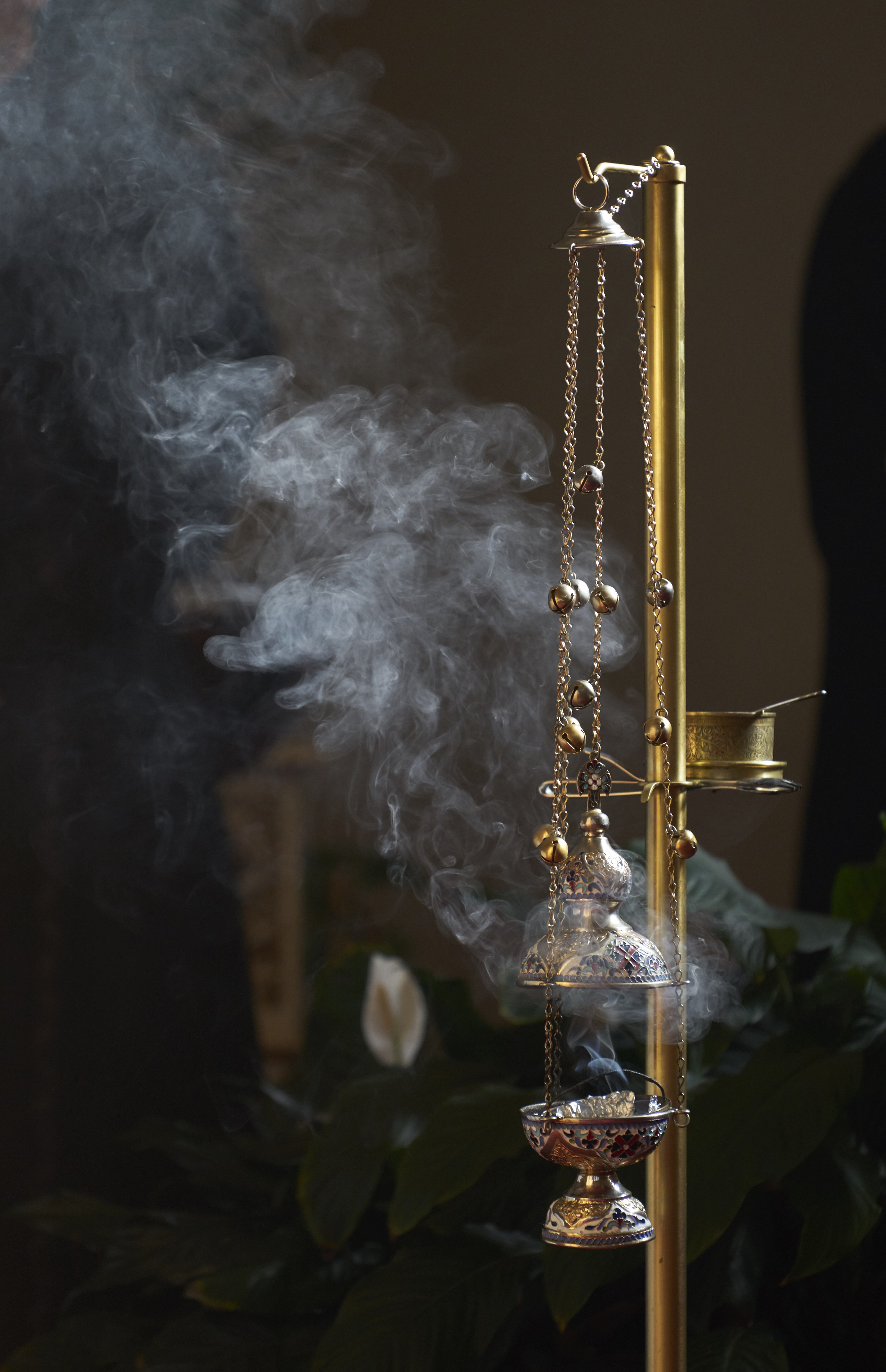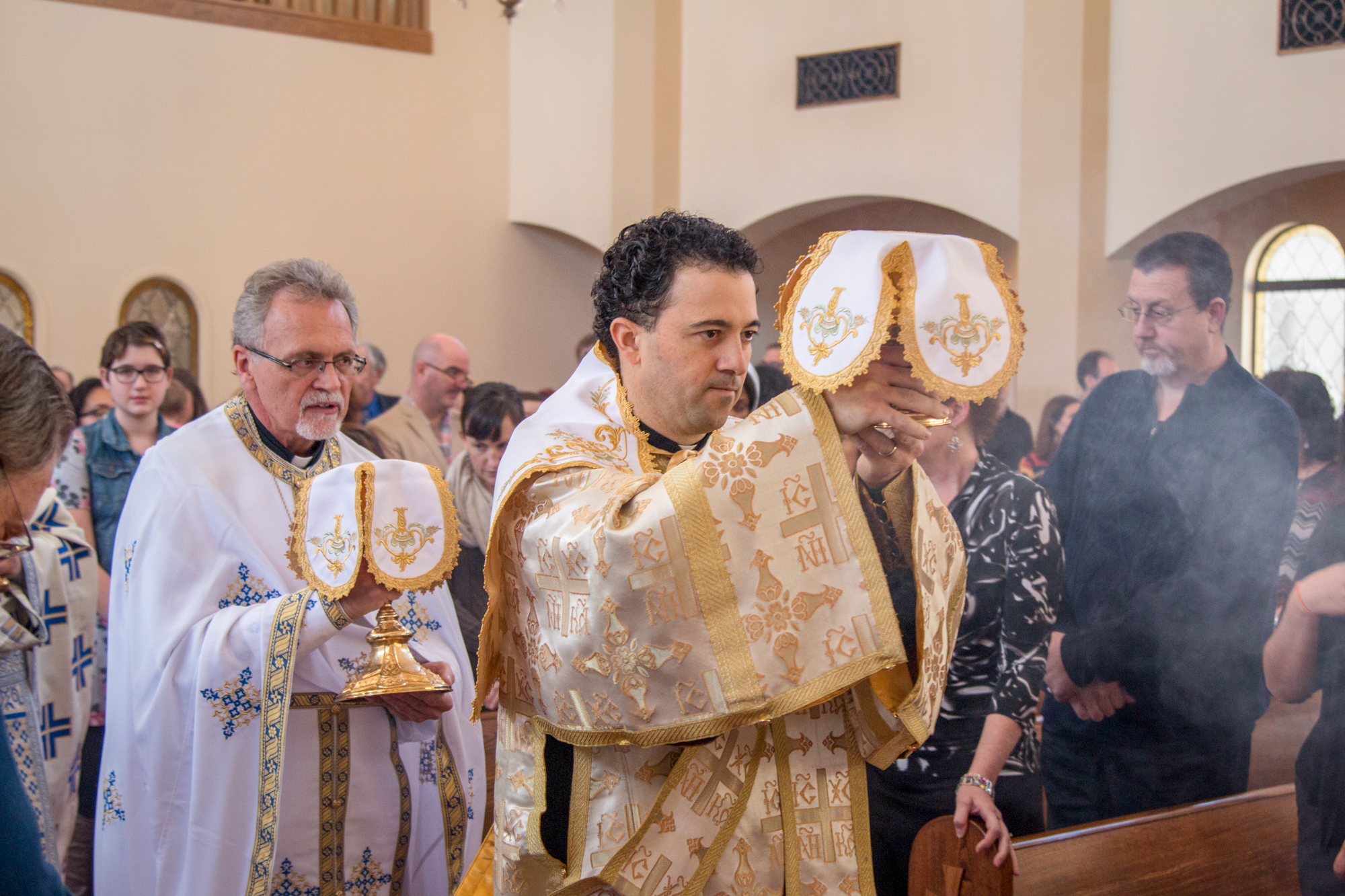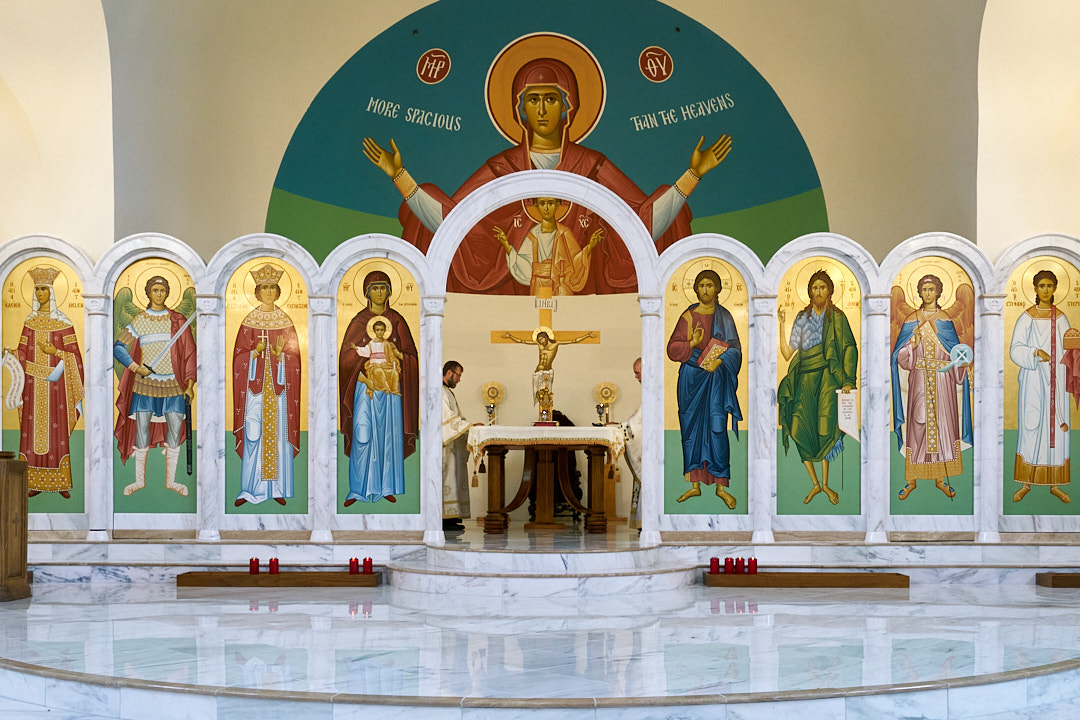Nothing compares with a hike in the Rocky Mountains on a beautiful day. The trail might meander past steep cliffs under impossibly blue skies, and in autumn, aspen trees lick the mountainsides in tongues of yellow flame. In summer, hikers can climb the boulders in Rocky Mountain National park as a waterfall tumbles into a creek flanked by pine and fir trees.

On a particularly arduous climb, hikers might stop to sit on a log and rest. By raising our eyes from the immediate path, we can truly experience, with all of our senses, the scenery. We discover new mysteries—the music of birdsong, the distinctive sigh of the breeze through the Ponderosa pines, and the delicate pink primroses blooming along the earthen path.
In her ancient wisdom, the Church has provided us with a spiritual rest area, a place to pause and slow down after we complete the first part of our journey of worship, the Liturgy of the Word. It’s easy to locate the spot, even without a map, because we can hear the change. A palpable shift occurs in the music as we ascend toward the Eucharist on the next part of the road.
The Cherubic Hymn
After the first five sections of the Liturgy of the Word, Section 6 takes us into the Liturgy of the Faithful. While the priest prays a prayer of repentance, the Cherubic Hymn begins. The meditative pace of the hymn, like a scenic stop on a trail, invites us to rest, to return our thoughts to Christ, to anticipate receiving His Body and Blood. This invitation to quiet, expectant worship is for me a highlight of the service. In Living the Liturgy, Fr. Stanley Harakas explains that the Cherubic Hymn “tells us how we ought to participate in the Liturgy at this point of the service” (p. 90).
The song has few words, sung slowly and with much repetition of phrases, allowing us to contemplate God’s incredible gift of Himself to us:
Let us who mystically represent the cherubim,
who sing the thrice-holy hymn to the life-creating Trinity…
The choir then urges us to:
now lay aside every worldly care…
turning away from our usual concerns. Why? To prepare ourselves
so that we may receive the King of all.

During the hymn, the priest and other clergy confess their own sins and unworthiness before God, asking our forgiveness. The slow singing and repetition in the hymn allow us time to take a deep breath and to search our own hearts for sins against God, neighbor, and self.
The priest prays and censes the altar, the icon screen, and the congregation. While the smoke of the incense rises along with our prayers to heaven (Rev. 5:8, 8:3-4), clergy and laity together praise God on earth and join the cherubim in song. Like the angels surrounding the throne of God, singing “Holy, holy holy” (Revelation), we function as earthly angels. We also “mystically represent” them: the Lord dwells between the cherubim (2 Sam. 6:2), and in Christ, His Spirit dwells among us too.
The Great Entrance Procession
The Great Entrance Procession begins, interrupting the hymn. The choir falls silent as the attendants and clergy proceed out of the Altar area into the Nave, which symbolizes the world. Usually an altar server leads, carrying the cross, while other attendants bear candles and liturgical fans.
As they walk among the people, the priest and any other clergy in attendance lift up the paten (or diskos), a footed plate carrying the bread for Communion, and the Chalice of mixed water and wine, both of them covered with beautiful embroidered cloths, usually with a cross at the center. When the procession reaches the center of church, the priest chants, sometimes with another clergyman echoing, words that remind us of the thief on the cross next to Jesus: “May the Lord God remember all of us in His Kingdom always, now and forever and to the ages of ages.”
Taking in the Scenery: The Priest’s Cape and the Doors

Let’s pause for a moment to take in some of the scenery surrounding the Great Entrance. You may notice during the procession that some of the laypeople extend their arms to touch the priest’s cape, or phelonion. This custom is an acknowledgment that the grace of the Holy Spirit infuses the physical world, not just the world of the spirit. In Jesus’ time, a woman with a flow of blood touched the hem of His garment and found instant healing; Jesus remarked that He felt power go out from Him to the woman through his clothing (Matthew 9, Mark 5, Luke 8). Other sick people also begged to touch His hem (Matt. 14:36, Mark 6:56), and after the gift of the Holy Spirit at Pentecost, Peter was so filled with the grace of God that the sick were laid on the streets so that his shadow might fall across them and bring healing (Acts 5:15).
This custom is not limited to the New Testament but continues to this day in the continuity of the Orthodox Church. I have fond memories of a faithful elderly woman, Rouli, who recently fell asleep in the Lord. She served for decades in my parish and always reached for the priest’s cape during the procession. But in her later years, Rouli was confined to a wheelchair and couldn’t extend her arms very easily. But with her wheelchair parked up front, next to the center aisle, and our priest, carefully carrying the Chalice, would swerve to his right when he passed her so that she could touch his cape.
She and others throughout the centuries have not reached out to touch the priest’s vestments because the priest himself is perfect or can offer healing and blessing apart from Christ. He too is in need of salvation, forgiveness, and healing. His priesthood carries the grace of apostolic succession, and he functions in his role as an icon (image) of Christ on earth. As the priest walks by, believers reach for his phelonion for a mystical blessing from the Lord, adding their personal prayers to the priest’s. I try to sit at the end of the pew so that I can do the same.
Hey—I’ll take all the blessings I can get.
As the priest and attendants return to the altar, the choir sings again, picking up the tempo, and we complete the Cherubic Hymn at a more jubilant pace. The words remind us once again, as we considered in our previous episode, that our worship takes place simultaneously on earth and in heaven: “By angelic hosts, invisibly escorted by angelic hosts,” followed by three Alleluias, which means “Let us praise the Lord” in Hebrew.
One unknown commentator in Living the Liturgy describes the word “alleluia” as “a cry for joy. ‘Alleluia’ faithfully expresses the loving gratitude, praise and admiration of Him whom angels and archangels, the cherubim and seraphim praise in the splendors of heaven” (Quoted in Harakas, p. 96).

As we reflect and prepare our hearts, anticipating the “heavenly and awesome Mysteries” ahead on our journey, take a look at some other activity you may not have noticed before. Note the entrances and exits located within the iconostasis (icon screen).
The main opening in front of the altar whose two gates usually form a diptych of the Annunciation—and often feature the icons of the four evangelists, Sts. Matthew, Mark, Luke, and John—are known as the Holy Doors (or the Beautiful Gate or the Royal Doors). These doors are reserved exclusively for the use of the bishop or a clergyman when he is carrying either the Gospel book or the Chalice containing the holy Eucharist.
Altar servers, including deacons, don’t just pop in and out through the nearest available opening. Most of the time they use the “deacon’s doors,” except when given a blessing to go through the Royal Doors in the center, usually carrying something, such as the Gospel or a censer.
The door used as the exit from the altar to the solea (the raised platform in front of the icon screen) usually depicts Archangel Michael; because the altar is often interpreted mystically as heaven, he is guarding the door. But the entrance to the altar on the other side features Archangel Gabriel, whose announcement of the Incarnation to the Virgin Mary marks humanity’s entrance to the heavenly realm.
The Litany of Completion
After the gifts are taken back into the altar, the priest chants, “Let us complete our prayer to the Lord… Help us, save us, have mercy on us, and protect us, O God, by Your grace.” This Litany of Completion is known as the Ektenia, from ektenes, “extended or long”—much longer than the Little Litany. This prayer asks the Lord for the well-being of the faithful, including requests for angelic protection, forgiveness, and a “Christian ending”to our lives. We respond with pleas of “Grant this, O Lord” instead of “Lord, have mercy.” It concludes with usual commemoration of the Virgin Mary and ascription to the Holy Trinity.
At this point, Father Harakas writes, “we are at the sacramental heart of the Divine Liturgy!” with…
Section 7: The Great Eucharistic Prayer
The largest portion of the Liturgy, Section 7, includes the Great Eucharistic Prayer. It is the most important sacramentally and also the most ancient part of the Divine Liturgy.
And yet—we are still not ready to receive the Body and Blood of our Lord. First we must seek peace with one another, affirm unity of belief through reciting the Creed, and pray a prayer of repentance together.
The service is progressing smoothly so far, but the Great Entrance is just about the only thing that’s happened at this point that is related to the Eucharist, except for that all-important preparation of our hearts. Clergy and laity share yet another blessing of peace, and we sing together a brief affirmation of our shared faith in the Holy Trinity: “Father, Son, and Holy Spirit: Trinity, one in essence and undivided.” (This hymn is also one of the more melodic ones, easier for me to remember than some of the others.)
This affirmation leads naturally to a longer profession of our Faith, the Nicene-Constantinopolitan Creed, an unwieldy mouthful often called simply the Creed. Just before the Creed comes the ancient practice of the Kiss of Peace, which has been omitted in some parishes. My own parish has retained it: the priest turns to face the worshipers and says, “Let us love one another,” then proclaims, “Christ is in our midst.” We respond, “He is and always shall be,” and greet one another with this same proclamation and response.
Father Harakas notes that “our unity in love is both the result of our unity in Faith and the presupposition of our sincere confession of faith in God who is love” (LL99). Can we receive the Eucharist while holding grudges and unforgiveness in our hearts? Of course. But the end result is judgment, not salvation. As Paul wrote in 1 Corinthians, “ he who eats and drinks in an unworthy manner eats and drinks judgment to himself, not discerning the Lord’s body” (11:29).

Next something occurs that feels odd and out of place to our modern ears. The priest announces, “The doors! The doors!” and instructs the catechumens to depart. In the old days, the catechumens traveling the liturgical journey took an alternate route and did not continue along the way with the faithful until after they were baptized. So the ancient Church directed the doorkeepers to keep out all unbelievers.
The Apostolic Constitutions, a collection of eight books written around AD 375, contains the instructions, “Let the door be watched, lest any unbeliever, or one not yet initiated, come in.”
Because the Eucharist is no longer a secret rite as it was in the early days, some parishes omit this small section of the liturgy. But I like it when parishes retain this part of the liturgy. The words remind us of the sanctity of the Eucharist. It is easy to take holy things for granted as just one part of our Sunday morning, which is just one part of our busy week. But these little historical artifacts in the service remind us that believers have died—and continue to die—for the privilege of gathering together to partake of the Body and Blood of Christ.
Confessing our Faith: The Creed
Our confession of faith was hammered out at the Council of Nicaea, convened by Constantine the Great in 325. With the guidance of the Holy Spirit, the priests and bishops chose each word with care, and it has lasted to this day as the definition of the Christian Faith and a bulwark against heretical teachings. An addition at Constantinople about fifty years later affirmed the divinity of the Holy Spirit, giving the Creed the accurate but unwieldy title of the “Nicaean-Constantinopolitan Creed.” (But “Nicene Creed” will do. I’ve printed it below.)
If a candidate for baptism could not sincerely confess the Creed, he would not be baptized. Even today, in our fractured world, the Nicene Creed is the definition of Christianity for Evangelicals, Eastern Orthodox, Roman Catholics, Baptists, Assemblies of God members—all professing Christians. It is a reliable and unchanging map of the historic Faith.
It is shocking how many modern Christians have never even heard of it. I vividly remember sitting around a table a few years ago with a heterodox group of Christians. Five or six of us were present, each from a different church—most of them nondenominational. I had distributed a copy of the Nicene Creed for everyone to read.
One woman in the group skimmed it quickly then said, “Well, I don’t agree with this!” I was so stunned by her flippant attitude that I didn’t think to ask which part she rejected. I was too busy wracking my brain to find a nice way to say, “Well, then, you’re a heretic.”
Sometimes silence really is the best response.
But her ignorance is not her fault. It is the fault of so many congregations whose leaders don’t bother with catechesis and who proclaim, “The Bible is our creed,” as if its words don’t need to be interpreted.
There is “one Lord, one faith, and one baptism” (Eph. 4:5), and the Orthodox Church is very clear on what that Faith proclaims. No creative theology is allowed here. As Fr. Lawrence Farley writes, “Sharing the common faith is a prerequisite to sharing the common sacrament” (Let Us Attend! A Journey through the Orthodox Divine Liturgy, p. 68).
This conviction is out of step with the individualistic Christianity of North Americans. Many people will say, “As long as you love Jesus, everything else is details.”

However, sincerity is not the measure of acceptability—or of Truth. “By confessing the creed immediately before praying the Eucharistic anaphora,” Fr. Lawrence continues, “the Church states unequivocally that it is not acceptable to believe just anything at all, and that belief is not just a private matter.”
Before we go forward to receive the Body and Blood of Christ, it is important that we agree just who this Jesus is. Saint Paul understood this and expressed his concern that the people of Corinth could be swayed by false teachings:
But I fear, lest somehow, as the serpent deceived Eve by his craftiness, so your minds may be corrupted from the simplicity that is in Christ. For if he who comes preaches another Jesus whom we have not preached, or if you receive a different spirit which you have not received, or a different gospel which you have not accepted—you may well put up with it! (1 Cor. 11:3-4).
By including the Creed in the Divine Liturgy, the Orthodox Church bears witness to the primacy of unchanging truth.
Together we have proclaimed the unchanging tenets of the Christian Faith in the Nicene Creed, and now the deacon cries out, “Let us stand aright! Let us stand with fear! Let us be attentive, that we may present the Holy Offering in peace.” A lovely back-and-forth between priest and people follows, since we make this offering together:
Let us lift up our hearts. / We lift them up unto the Lord.
Let us give thanks to the Lord. / It is proper and right.

The honor given to the bread and the wine in the Orthodox Church is radically different from my experiences of communion in various Protestant churches—a simple passing of trays of plastic cups and bits of cracker. The reason for all the prayers, praises, and pleas for forgiveness lies in the nature of the offering itself. If communion is more than the sum of its physical parts, and if Christ truly gives Himself to us in the bread and the wine, we should not approach the chalice casually. To receive the King of kings, we must give Him adequate time and attention.
We will delve into the Eucharist and its meaning to us as individuals and as a community, but since we’re in the middle of the Nativity fast, so close to Christmas, I thought this would be a good time to think about the Virgin Mary. As I’ve learned from decades of experience in various corners of the Evangelical world, this is pretty much the only season of the year when Protestants give her any thought at all.
So we will concentrate on one aspect of the life of the Theotokos that was once believed by Protestants but has been largely abandoned in only the last two hundred years: her ever-virginity. We’ll look at Old Testament prophecy and the Church Fathers. I hope you will be inspired and grow in love for her as we consider her obedience, her purity, and her vital role in the Incarnation.
Good strength to you!
+ the nicene creed +
[The following is the official English translation used by the Greek Orthodox Archdiocese of America.]
I believe in one God, Father Almighty, Creator of
heaven and earth, and of all things visible and invisible.
And in one Lord Jesus Christ, the only-begotten Son of
God, begotten of the Father before all ages;
Light of Light, true God of true God, begotten,
not created, of one essence with the Father
through Whom all things were made.
Who for us men and for our salvation
came down from heaven and was incarnate
of the Holy Spirit and the Virgin Mary and became man.
He was crucified for us under Pontius Pilate,
and suffered and was buried;
And He rose on the third day,
according to the Scriptures.
He ascended into heaven
and is seated at the right hand of the Father;
And He will come again with glory to judge the living
and dead. His kingdom shall have no end.
And in the Holy Spirit, the Lord, the Creator of life,
Who proceeds from the Father, Who together with the
Father and the Son is worshipped and glorified, Who
spoke through the prophets.
In one, holy, catholic, and apostolic Church.
I confess one baptism for the forgiveness of sins.
I look for the resurrection of the dead,
and the life of the age to come.
Amen.
Another good installment in a useful series for the faithful on the Divine Liturgy. You’ve synthesized a lot of information from various sources.
However, just a couple of corrections. You say “The bread and wine are transferred from the Table of Preparation to the Holy Table—this goes on behind the iconostasis, out parishioners’s view.” [sic] but this is not the case. The bread and wine are taken up by the clergy at the Table of Preparation and then we begin the Great Entrance, which is precisely their transfer to the Holy Table and is in full view, as you note, of the faithful.
Also, it’s not the case that the deacons “always” use the deacon’s doors. In specific cases, but actually many times, the deacon has a blessing to go through the Royal Doors (usually carrying something: the Gospel, the diskos at the end of the Great Entrance, a censer, etc.).
Thank you, Dn. Nicholas. Each book appears to have slightly different information, sometimes based on variations in practice. I’ll fiddle with the wording tomorrow to correct these things. I appreciate the fact-checking!
Changes made!
Thank you.